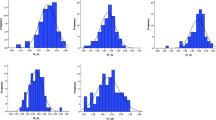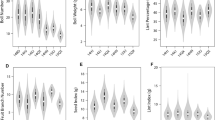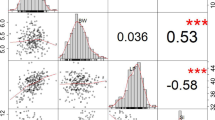Abstract
Key message
Thirty significant associations between 22 SNPs and five plant architecture component traits in Chinese upland cotton were identified via GWAS. Four peak SNP loci located on chromosome D03 were simultaneously associated with more plant architecture component traits. A candidate gene, Gh_D03G0922, might be responsible for plant height in upland cotton.
Abstract
A compact plant architecture is increasingly required for mechanized harvesting processes in China. Therefore, cotton plant architecture is an important trait, and its components, such as plant height, fruit branch length and fruit branch angle, affect the suitability of a cultivar for mechanized harvesting. To determine the genetic basis of cotton plant architecture, a genome-wide association study (GWAS) was performed using a panel composed of 355 accessions and 93,250 single nucleotide polymorphisms (SNPs) identified using the specific-locus amplified fragment sequencing method. Thirty significant associations between 22 SNPs and five plant architecture component traits were identified via GWAS. Most importantly, four peak SNP loci located on chromosome D03 were simultaneously associated with more plant architecture component traits, and these SNPs were harbored in one linkage disequilibrium block. Furthermore, 21 candidate genes for plant architecture were predicted in a 0.95-Mb region including the four peak SNPs. One of these genes (Gh_D03G0922) was near the significant SNP D03_31584163 (8.40 kb), and its Arabidopsis homologs contain MADS-box domains that might be involved in plant growth and development. qRT-PCR showed that the expression of Gh_D03G0922 was upregulated in the apical buds and young leaves of the short and compact cotton varieties, and virus-induced gene silencing (VIGS) proved that the silenced plants exhibited increased PH. These results indicate that Gh_D03G0922 is likely the candidate gene for PH in cotton. The genetic variations and candidate genes identified in this study lay a foundation for cultivating moderately short and compact varieties in future Chinese cotton-breeding programs.






Similar content being viewed by others
Abbreviations
- PH:
-
Plant height
- FBL:
-
Fruit branch length
- FBA:
-
Fruit branch angle
- FFBP:
-
First fruit branch position
- HFFBP:
-
Height of the first fruit branch position
- AY:
-
Anyang
- SHZ:
-
Shihezi
- QTL:
-
Quantitative trait loci
- SNPs:
-
Single nucleotide polymorphisms
- GWAS:
-
Genome-wide association study
- LD:
-
Linkage disequilibrium
- SLAF-seq:
-
Specific-locus amplified fragment sequencing
- BLUPs:
-
Best linear unbiased predictions
- MLM:
-
Mixed linear model
- MAF:
-
Minor allele frequency
- ANOVA:
-
Analysis of variance
- VIGS:
-
Virus-induced gene silencing
References
Adams SR, Pearson S, Hadley P (1997) The effects of temperature and photoperiod on the flowering and morphology of trailing petunias. Acta Hortic 435:65–76
Alexander DH, Novembre J, Lange K (2009) Fast model-based estimation of ancestry in unrelated individuals. Genome Res 19:1655–1664
Bednarz CW, Bridges DC, Brown SM (2000) Analysis of cotton yield stability across population densities. Semigroup Forum 92:128–135
Bridge RR, Meredith WR, Chism JF (1973) Influence of planting method and plant population on cotton (Gossypium hirsutum L.). Agron J 65:104–109
Chen ZJ, Scheffler BE, Dennis E, Triplett BA, Zhang TZ, Guo WZ, Chen XY et al (2007) Toward sequencing cotton (Gossypium) genomes. Plant Physiol 145:1303–1310
Chen W, Yao JB, Chu L, Yuan Z, Li Y, Zhang YS (2015) Genetic mapping of the nulliplex-branch gene (gb_nb1) in cotton using next-generation sequencing. Theor Appl Genet 128:539–547
Crowell S, Korniliev P, Falcão A, Ismail A, Gregorio G, Mezey J, Mccouch S (2016) Genome-wide association and high-resolution phenotyping link Oryza sativa panicle traits to numerous trait-specific QTL clusters. Nat Commun 7:10527
Danecek P, Auton A, Abecasis G, Albers CA, Banks E, DePristo MA, Handsaker RE et al (2011) The variant call format and VCFtools. Bioinformatics 27:2156–2158
Deng FJ, Lin H, Su JJ, Han HY (2011) Relation of yield forming and planting density in cotton. Xinjiang Agric Sci 48:2191–2196
Dong HZ, Li WJ, Tang W, Li ZH, Zhang DM (2006) Effects of genotypes and plant density on yield, yield components and photosynthesis in Bt transgenic cotton. J Agron Crop Sci 192:132–139
Dong HZ, Kong XQ, Li WJ, Tang W, Zhang DM (2010) Effects of plant density and nitrogen and potassium fertilization on cotton yield and uptake of major nutrients in two fields with varying fertility. Field Crops Res 119:106–113
Duvick DN (2005) Genetic progress in yield of United States maize (Zea mays L.). Maydica 50:193–202
Eaton FM (1955) Physiology of the cotton plant. Annu Rev Plant Physiol 6:299–328
Fang L, Wang Q, Hu Y, Jia YH, Chen JD, Liu BL, Zhang ZY et al (2017) Genomic analyses in cotton identify signatures of selection and loci associated with fiber quality and yield traits. Nat Genet 49:1089–1098
Flint-Garcia SA, Thornsberry JM, Buckler ES (2003) Structure of linkage disequilibrium in plants. Annu Rev Plant Biol 54:357–374
Fowler JL, Ray LL (1977) Response of two cotton genotypes to five equidistant spacing patterns. Agron J 69:733–738
Furbank RT, Tester M (2011) Phenomics-technologies to relieve the phenotyping bottleneck. Trends Plant Sci 16:635–644
Gore MA, Fang DD, Poland JA, Zhang JF, Percy RG, Cantrell RG, Thyssen G et al (2014) Linkage map construction and quantitative trait locus analysis of agronomic and fiber quality traits in cotton. Plant Genome 7:1–10
Gu Q, Ferrándiz C, Yanofsky MF, Martienssen R (1998) The FRUITFULL MADS-box gene mediates cell differentiation during Arabidopsis fruit development. Development 125:1509–1517
Gu ZH, Huang CJ, Li FF, Zhou XP (2014) A versatile system for functional analysis of genes and microRNAs in cotton. Plant Biotechnol J 12:638–649
He R, Shi YZ, Zhang JF, Liang Y, Zhang BC, Li JW, Wang T et al (2014) QTL mapping for plant height using chromosome segment substitution lines in upland cotton. Acta Agron Sin 40:457–465
Hempel FD, Weigel D, Mandel MA, Ditta G, Zambryski PC, Feldman LJ, Yanofsky MF (1997) Floral determination and expression of floral regulatory genes in Arabidopsis. Development 124:3845–3853
Houle D, Govindaraju DR, Omholt S (2010) Phenomics, the next challenge. Nat Rev Genet 11:855–866
Huang C, Nie XH, Shen C, You CY, Li W, Zhao WX, Zhang XL, Lin ZX (2017) Population structure and genetic basis of the agronomic traits of upland cotton in China revealed by a genome-wide association study using high-density SNPs. Plant Biotechnol J 3:1–13
Jia XY, Pang CY, Wei HL, Wang HT, Ma QF, Yang JL, Cheng SS et al (2016) High-density linkage map construction and QTL analysis for earliness-related traits in Gossypium hirsutum L. BMC Genom 17:909
Jiang C, Wright RJ, Woo SS, Delmonte TA, Paterson AH (2000) QTL analysis of leaf morphology in tetraploid Gossypium (cotton). Theor Appl Genet 100:409–418
Kumagai MH, Donson J, Della-Cioppa G, Harvey D, Hanley K, Grill LK (1995) Cytoplasmic inhibition of carotenoid biosynthesis with virus-derived RNA. Proc Natl Acad Sci USA 92:1679–1683
Li H, Handsaker B, Wysoker A, Fennell T, Ruan J, Homer N, Marth G, Abecasis G, Durbin R (2009) 1000 genome project data processing subgroup: the sequence alignment/map format and SAMtools. Bioinformatics 25:2078–2079
Li CQ, Song L, Zhao HH, Wang QL, Fu YZ (2014) Identification of quantitative trait loci with main and epistatic effects for plant architecture traits in Upland cotton (Gossypium hirsutum L.). Plant Breed 133:390–400
Li FG, Fan GY, Lu CR, Xiao GH, Zou CS, Kohel RJ, Ma ZY et al (2015) Genome sequence of cultivated upland cotton (Gossypium hirsutum TM-1) provides insights into genome evolution. Nat Biotechnol 33:524–530
Li CQ, Ai NJ, Zhu YJ, Wang YQ, Chen XD, Li F, Hu QY et al (2016) Association mapping and favourable allele exploration for plant architecture traits in upland cotton (Gossypium hirsutum L.) accessions. J Agric Sci 154:567–583
Li TG, Ma XF, Li NY, Zhou L, Liu Z, Han HY, Gui YJ et al (2017) Genome-wide association study discovered candidate genes of Verticillium wilt resistance in upland cotton (Gossypium hirsutum L.). Plant Biotechnol J 3:1–13
Lipka AE, Tian F, Wang QS, Peiffer J, Li M, Bradbury PJ, Gore MA et al (2012) GAPIT, genome association and prediction integrated tool. Bioinformatics 28:2397–2399
Liu YX, Wang L, Mao SS, Liu K, Lu YL, Wang JR, Wei YM et al (2015) Genome-wide association study of 29 morphological traits in Aegilops tauschii. Sci Rep 5:15562
Liu J, Wang WX, Mei DS, Wang H, Fu L, Liu DM, Li YC et al (2016a) Characterizing variation of branch angle and genome-wide association mapping in rapeseed (Brassica napus L.). Front Plant Sci 7:21
Liu X, Feng ZM, Zhou CL, Ren YK, Mou CL, Wu T, Yang CY et al (2016b) Brassinosteroid (BR) biosynthetic gene lhdd10 controls late heading and plant height in rice (Oryza sativa L.). Plant Cell Rep 35:357–368
Livak KJ, Schmittgen TD (2001) Analysis of relative gene expression data using real-time quantitative PCR and the 2−ΔΔCT method. Methods 25:402–408
Lu Q, Zhang MC, Niu XJ, Wang S, Xu Q, Feng Y, Wang CH et al (2015) Genetic variation and association mapping for 12 agronomic traits in indica rice. BMC Genom 16:1067
Luo HL, Chen SM, Jiang JF, Teng NJ, Chen Y, Chen FD (2012) The AP2-like gene NsAP2 from water lily is involved in floral organogenesis and plant height. J Plant Physiol 169:992–998
Mao LL, Zhang LZ, Zhao XH, Liu SD, van der Werf W, Zhang SP, Spiertz H et al (2014) Crop growth, light utilization and yield of relay intercropped cotton as affected by plant density and a plant growth regulator. Field Crops Res 155:67–76
Mao LL, Zhang LZ, Evers JB, van der Werf W, Liu SD, Zhang SP, Wang BM et al (2015) Yield components and quality of intercropped cotton in response to mepiquat chloride and plant density. Field Crops Res 179:63–71
Mcgarry RC, Ayre BG (2012) Manipulating plant architecture with members of the CETS gene family. Plant Sci 188–189:71–81
Mcgarry RC, Prewitt S, Ayre BG (2013) Overexpression of FT in cotton affects architecture but not floral organogenesis. Plant Signal Behav 8:e23602
McKenna A, Hanna M, Banks E, Sivachenko A, Cibulskis K, Kernytsky A, Garimella K, Altshuler D, Gabriel S, Daly M, DePristo MA (2010) The Genome Analysis Toolkit: a MapReduce framework for analyzing next-generation DNA sequencing data. Genome Res 20:1297–1303
Monna L, Kitazawa N, Yoshino R, Suzuki J, Masuda H, Maehara Y, Tanji M et al (2002) Positional cloning of rice semidwarfing gene, sd-1: rice “green revolution gene” encodes a mutant enzyme involved in gibberellin synthesis. DNA Res 9:11–17
Morris GP, Ramu P, Deshpande SP, Hash CT, Shah T, Upadhyaya HD, Riera-Lizarazu O et al (2013) Population genomic and genome-wide association studies of agroclimatic traits in sorghum. Proc Natl Acad Sci USA 110:453–458
Oosterhuis D (2001) Physiology and nutrition of high yielding cotton in the USA. Inform Agron 95:18–24
Paterson AH, Brubaker CL, Wendel JF (1993) A rapid method for extraction of cotton (Gossypium spp.) genomic DNA suitable for RFLP or PCR analysis. Plant Mol Biol Rep 11:122–127
Pauli D, Andrade-Sanchez P, Carmo-Silva AE, Gazave E, French AN, Heun J, Hunsaker DJ et al (2016) Field-based high-throughput plant phenotyping reveals the temporal patterns of quantitative trait loci associated with stress-responsive traits in cotton. G3 6:865–879
Peng J, Richards DE, Hartley NM, Murphy GP, Devos KM, Flintham JE, Beales J et al (1999) ‘Green revolution’ genes encode mutant gibberellin response modulators. Nature 400:256–261
Phinney BO (1956) Growth response of single-gene dwarf mutants in maize to gibberellic acid. Proc Natl Acad Sci USA 42:185–189
Qi JJ, Liu X, Shen D, Miao H, Xie BY, Li XX, Zeng P et al (2013) A genomic variation map provides insights into the genetic basis of cucumber domestication and diversity. Nat Genet 45:1510–1515
Ren XM, Zhang LZ, Du MW, Evers JB, van der Werf W, Tian XL, Li ZH (2013) Managing mepiquat chloride and plant density for optimal yield and quality of cotton. Field Crops Res 149:1–10
Saeed M, Guo WZ, Ullah I, Tabbasam N, Zafar Y, Zhang T (2011) QTL mapping for physiology, yield and plant architecture traits in cotton (Gossypium hirsutum L.) grown under well-watered versus water-stress conditions. Electron J Biotechnol 14:1–13
Sakamoto T, Matsuoka M (2004) Generating high-yielding varieties by genetic manipulation of plant architecture. Curr Opin Biotechnol 15:144–147
Sakamoto T, Miura K, Itoh H, Tatsumi T, Ueguchi-Tanaka M, Ishiyama K, Kobayashi M et al (2004) An overview of gibberellin metabolism enzyme genes and their related mutants in rice. Plant Physiol 134:1642–1653
Sasaki A, Ashikari M, Ueguchi-Tanaka M, Itoh H, Nishimura A, Swapan D, Ishiyama K et al (2002) Green revolution, a mutant gibberellin-synthesis gene in rice. Nature 416:701–702
Shang LG, Liu F, Wang YM, Abduweli A, Cai SH, Wang KB, Hua JP (2015) Dynamic QTL mapping for plant height in upland cotton (Gossypium hirsutum). Plant Breed 134:703–712
Shang LG, Ma LL, Wang YM, Su Y, Wang XC, Li YH, Abduweli A et al (2016) Main effect QTL with dominance determines heterosis for dynamic plant height in upland cotton. G3 6:3373–3379
Shin JH, Blay S, Mcneney B, Graham J (2006) LDheatmap: an R function for graphical display of pairwise linkage disequilibria between single. J Stat Softw 16:1–10
Sinkar VP, Pythoud F, White FF, Nester EW, Gordon MP (1988) rolA locus of the Ri plasmid directs developmental abnormalities in transgenic tobacco plants. Genes Dev 2:688–697
Song XL, Zhang TZ (2009) Quantitative trait loci controlling plant architectural traits in cotton. Plant Sci 177:317–323
Su JJ, Pang CY, Wei HL, Li LB, Liang B, Wang CX, Song MZ et al (2016) Identification of favorable SNP alleles and candidate genes for traits related to early maturity via GWAS in upland cotton. BMC Genom 17:687
Sun L, Monneuse MO, Martin-Tanguy J, Tepfer D (1991) Changes in flowering and the accumulation of polyamines and hydroxycinnamic acid-polyamine conjugates in tobacco plants transformed by the rolA locus from the Ri TLDNA of Agrobacterium rhizogenes. Plant Sci 80:145–156
Sun X, Liu D, Zhang X, Li W, Liu H, Hong W, Jiang C et al (2013) SLAF-seq, an efficient method of large-scale de novo SNP discovery and genotyping using high-throughput sequencing. PLoS ONE 8:e58700
Sun ZW, Wang XF, Liu ZW, Gu QS, Zhang Y, Li ZK, Ke HF et al (2017) Genome-wide association study discovered genetic variation and candidate genes of fibre quality traits in Gossypium hirsutum L. Plant Biotechnol J 1:1–15
Wang BH, Wu YT, Huang NT, Zhu XF, Guo WZ, Zhang TZ (2006) QTL mapping for plant architecture traits in upland cotton using RILs and SSR markers. Acta Genet Sin 33:161–170
Wang HT, Jin X, Zhang BB, Shen C, Lin ZX (2015a) Enrichment of an intraspecific genetic map of upland cotton by developing markers using parental RAD sequencing. DNA Res 22:147–160
Wang YK, Ning ZY, Hu Y, Chen JD, Zhao R, Chen H, Ai NJ et al (2015b) Molecular mapping of restriction-site associated DNA markers in allotetraploid upland cotton. PLoS ONE 10:e0124781
Warner RM (2010) Temperature and photoperiod influence flowering and morphology of four Petunia spp. HortScience 45:365–368
Yang WN, Duan LF, Chen GX, Xiong LZ, Liu Q (2013) Plant phenomics and high-throughput phenotyping, accelerating rice functional genomics using multidisciplinary technologies. Curr Opin Plant Biol 16:180–187
Yang N, Lu YL, Yang XH, Huang J, Zhou Y, Ali F, Wen WW et al (2014a) Genome wide association studies using a new nonparametric model reveal the genetic architecture of 17 agronomic traits in an enlarged maize association panel. PLoS Genet 10:821–833
Yang WN, Guo ZL, Huang CH, Duan LF, Chen GX, Jiang N, Fang W et al (2014b) Combining high-throughput phenotyping and genome-wide association studies to reveal natural genetic variation in rice. Nat Commun 5:5087
Yu SX, Huang ZM (1990) Inheritance analysis on earliness components of short season cotton varieties in G. hirsutum. Sci Agric Sin 23:48–54
Zhang WF, Wang ZL, Yu SJ, Li SK, Fang J, Tong WS (2004) Effects of planting density on canopy photosynthesis, canopy structure and yield formation of high-yield cotton in Xinjiang, China. Chin J Plant Ecol 28:164–171
Zhang PT, Zhu XF, Guo WZ, Yu JZ, Zhang TZ (2006) Inheritance and QTLs tagging for ideal plant architecture of simian 3 using molecular markers. Cotton Sci 18:13–18
Zhang TZ, Hu Y, Jiang WK, Fang L, Guan XY, Chen JD, Zhang JB et al (2015) Sequencing of allotetraploid cotton (Gossypium hirsutum L. acc TM-1) provides a resource for fiber improvement. Nat Biotechnol 33:531–537
Zhang Z, Shang HH, Shi YZ, Huang L, Li JW, Ge Q, Gong JW et al (2016) Construction of a high-density genetic map by specific locus amplified fragment sequencing (SLAF-seq) and its application to quantitative trait loci (QTL) analysis for boll weight in upland cotton (Gossypium hirsutum L.). BMC Plant Biol 16:79
Zhao XH, Cao D, Huang ZJ, Wang JL, Lu SJ, Xu Y, Liu BH et al (2015) Dual functions of GmTOE4a in the regulation of photoperiod-mediated flowering and plant morphology in soybean. Plant Mol Biol 88:343
Zhao J, Mantilla Perez MB, Hu JY, Salas Fernandez MG (2016) Genome-wide association study for nine plant architecture traits in sorghum. Plant Genome 9:1–14
Acknowledgements
This research was funded by the Chinese National Natural Science Foundation (31660409, 31601346 and 31621005) and the China Agriculture Research System (CARS-15-06).
Author information
Authors and Affiliations
Corresponding author
Ethics declarations
This research complied with ethical standards.
Conflict of interest
The authors declare no conflicts of interest.
Availability of supporting data
The sequence read data from the SLAF-seq analysis for the 355 sequenced upland cotton lines are available in the Sequence Read Archive (http://www.ncbi.nlm.nih.gov/bioproject/PRJNA314284/) (SRP071133 under the Accession Number PRJNA314284).
Additional information
Communicated by Diane E. Mather.
Electronic supplementary material
Below is the link to the electronic supplementary material.
Rights and permissions
About this article
Cite this article
Su, J., Li, L., Zhang, C. et al. Genome-wide association study identified genetic variations and candidate genes for plant architecture component traits in Chinese upland cotton. Theor Appl Genet 131, 1299–1314 (2018). https://doi.org/10.1007/s00122-018-3079-5
Received:
Accepted:
Published:
Issue Date:
DOI: https://doi.org/10.1007/s00122-018-3079-5




